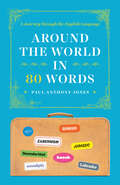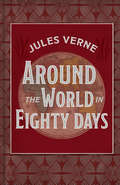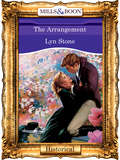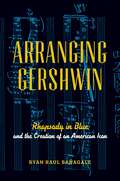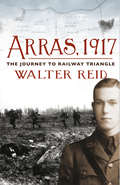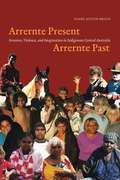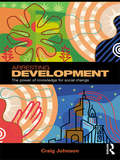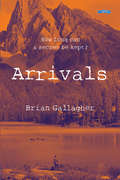- Table View
- List View
Around the World in 80 Words: A Journey through the English Language
by Paul Anthony JonesWhat makes a place so memorable that it survives forever in a word? In this captivating round-the-world tour, Paul Anthony Jones acts as your guide through the intriguing stories of how eighty places became immortalized in the English language. You’ll discover why the origins of turkeys, limericks, Brazil nuts, and Panama hats aren’t quite as straightforward as you might presume. If you’ve never heard of the tiny Czech mining town of Jáchymov—or Joachimsthal, as it was known until the late 1800s—you’re not alone, which makes its claim to fame as the origin of the word “dollar” all the more extraordinary. The story of how the Great Dane isn’t all that Danish makes the list, as does the Jordanian mountain whose name has become a byword for a tantalizing glimpse. We’ll also find out what the Philippines has given to your office inbox, what Alaska has given to your liquor cabinet, and how a speech given by a bumbling North Carolinian gave us a word for impenetrable nonsense. Surprising, entertaining, and illuminating, this is essential reading for armchair travelers and word nerds. Our dictionaries are full of hidden histories, tales, and adventures from all over the world—if you know where to look.
Around the World in 80 Words: A Journey through the English Language
by Paul Anthony JonesWhat makes a place so memorable that it survives forever in a word? In this captivating round-the-world tour, Paul Anthony Jones acts as your guide through the intriguing stories of how eighty places became immortalized in the English language. You’ll discover why the origins of turkeys, limericks, Brazil nuts, and Panama hats aren’t quite as straightforward as you might presume. If you’ve never heard of the tiny Czech mining town of Jáchymov—or Joachimsthal, as it was known until the late 1800s—you’re not alone, which makes its claim to fame as the origin of the word “dollar” all the more extraordinary. The story of how the Great Dane isn’t all that Danish makes the list, as does the Jordanian mountain whose name has become a byword for a tantalizing glimpse. We’ll also find out what the Philippines has given to your office inbox, what Alaska has given to your liquor cabinet, and how a speech given by a bumbling North Carolinian gave us a word for impenetrable nonsense. Surprising, entertaining, and illuminating, this is essential reading for armchair travelers and word nerds. Our dictionaries are full of hidden histories, tales, and adventures from all over the world—if you know where to look.
Around the World in 80 Words: A Journey through the English Language
by Paul Anthony JonesWhat makes a place so memorable that it survives forever in a word? In this captivating round-the-world tour, Paul Anthony Jones acts as your guide through the intriguing stories of how eighty places became immortalized in the English language. You’ll discover why the origins of turkeys, limericks, Brazil nuts, and Panama hats aren’t quite as straightforward as you might presume. If you’ve never heard of the tiny Czech mining town of Jáchymov—or Joachimsthal, as it was known until the late 1800s—you’re not alone, which makes its claim to fame as the origin of the word “dollar” all the more extraordinary. The story of how the Great Dane isn’t all that Danish makes the list, as does the Jordanian mountain whose name has become a byword for a tantalizing glimpse. We’ll also find out what the Philippines has given to your office inbox, what Alaska has given to your liquor cabinet, and how a speech given by a bumbling North Carolinian gave us a word for impenetrable nonsense. Surprising, entertaining, and illuminating, this is essential reading for armchair travelers and word nerds. Our dictionaries are full of hidden histories, tales, and adventures from all over the world—if you know where to look.
Around the World in 80 Words: A Journey through the English Language
by Paul Anthony JonesWhat makes a place so memorable that it survives forever in a word? In this captivating round-the-world tour, Paul Anthony Jones acts as your guide through the intriguing stories of how eighty places became immortalized in the English language. You’ll discover why the origins of turkeys, limericks, Brazil nuts, and Panama hats aren’t quite as straightforward as you might presume. If you’ve never heard of the tiny Czech mining town of Jáchymov—or Joachimsthal, as it was known until the late 1800s—you’re not alone, which makes its claim to fame as the origin of the word “dollar” all the more extraordinary. The story of how the Great Dane isn’t all that Danish makes the list, as does the Jordanian mountain whose name has become a byword for a tantalizing glimpse. We’ll also find out what the Philippines has given to your office inbox, what Alaska has given to your liquor cabinet, and how a speech given by a bumbling North Carolinian gave us a word for impenetrable nonsense. Surprising, entertaining, and illuminating, this is essential reading for armchair travelers and word nerds. Our dictionaries are full of hidden histories, tales, and adventures from all over the world—if you know where to look.
Around the World in Eighty Days: In English Translation
by Jules VerneA popular adventure novel originally published in 1873, Around the World in Eighty Days is the story of Phileas Fogg and his newly employed French valet, Jean Passepartout, who attempt to circumnavigate the world in 80 days on a £20,000 bet with Fogg’s friends at the Reform Club. In a race against time, Fogg and Passepartout employ virtually every means of transportation necessary to achieve their goal—with a devious detective introducing new obstacles every step of the way. Against a constantly shifting backdrop of exotic and exciting locations—the jungles of India, opium dens in China, a Japanese circus, and a train under attack—Around the World in Eighty Days is an enduring blend of comic adventures (and misadventures) and suspense that continues to enchant readers new and old. Penguin Random House Canada is proud to bring you classic works of literature in e-book form, with the highest quality production values. Find more today and rediscover books you never knew you loved.
Arran: A History
by Thorbjørn CampbellArran is an archaeological and geological treasure trove of stunning scenic beauty. Its history stretches back to the great stone circles, more than 5,000 years old, whose remnants still decorate the plains of Machrie. Runic inscriptions tell of a Viking occupation lasting centuries. Later, in 1307, King Robert the Bruce began his triumphant comeback from Arran. Subsequently, the island was repeatedly caught up and devastated in the savage dynastic struggles of medieval Scotland. After the 1707 Parliamentary Union, came a new and strange upheaval - unwarlike but equally unsettling: Arran became a test-bed for the new theories of the ideologists of the Industrial Revolution. The ancient 'runrig' style of farming gave way to enclosed fields and labour-saving methods, which eventually lead to the socially disastrous Highland Clearances to Arran, and the misfortune of the times was culminated by the Great Irish Potato Famine of 1845. At last, the area began to settle down through an increasingly stable mixture of agriculture and tourism in the 19th and 20th centuries. In this book, Thorbjorn Campbell gives an original, fascinating and comprehensive account of Arran's long and eventful history.
The Arran Malt: An Island Whisky Renaissance
by Neil WilsonDespite being only 21 years old, Lochranza Distillery on the Isle of Arran is the latest in a long line of distilleries that once existed there. The island's illicit whisky that was made in the 18th century was considered so good that it was on a par with the best smuggled Glenlivet and the Skye traveller John MacCulloch recorded in 1824 that Arran Water, as it was called, 'in the older days, was the burgundy of all the vintages.' The last legal distillery on Arran closed in 1837 and it was not until David Hutchison, a Glasgow architect whose family had property on Arran, attended a dinner of the Arran Society of Glasgow in March 1991, that the idea to start a new distillery took seed. He approached his friend Harold Currie, a retired ex-Chivas Regal MD, and together they brought about the creation of Lochranza Distillery which started production in June 1995.But that's not the whole story as the project was beset by NIMBY objectors, nesting eagles, licensing problems, SNH concerns regarding the impact on a National Scenic Area, European environmental regulations, and, once approved, a race to raise sufficient finance. But despite all that, the distillery was built and is now world-renowned for the quality of its spirit. Neil Wilson has spent a year researching the company and its evolution and has written an entertaining insight into the history of how the distillery was created and how it has evolved with full financial disclosure which shows that without the support of two major shareholders, the whole business would have collapsed in the first decade of the new millennium.Now Arran is seen as the inspiration that has brought over 20 or so new distilleries of varying sizes into creation since 2000 across the length and breadth of Scotland. The story reveals how the Currie family's interests in the company were eventually subsumed by shareholder power and control passed to the current owners who continue to invest heavily in the future. And the book also reveals plans of the company's new proposed distillery in the south of Arran which will, subject to approval, produce the peated varieties of Arran malt. It is a fascinating story, illustrated with archive and contemporary illustrations and includes interviews with many of the people who have been involved in the story from the start.
Arran Water: An Island Whisky History
by Gregor Adamson‘Arran Water’, the term for whisky distilled illicitly on the Isle of Arran, was revered for its quality throughout Scotland during the heydays of smuggling in the late 18th and early 19th centuries. Despite this reputation, Arran’s rich distilling past has long been forgotten, cast into the shadows of more illustrious whisky-making neighbours such as Campbeltown and Islay.This pioneering book is the first to chart this fascinating aspect of the island’s history. In Arran Water Gregor Adamson provides a comprehensive first-hand account of distilling on the island from the emergence of clandestine manufacture in the late 18th century to the construction of the new distillery at Lagg in 2018 by Isle of Arran Distillers which reinstated legal whisky production on the island after 160 years with the establishment of a distillery at Lochranza in 1995.Arran Water dispels the myths, hearsay and folktales that have distorted Arran’s distilling story and provides a clear narrative, largely through primary research, which highlights the key role that illicit whisky production and smuggling played in the island’s economic, social and cultural development.Using a vast array of original sources, Adamson outlines the manufacture, transportation, and consumption of sma’ still whisky, unearths the secrets of the hidden bothies of the Arran hills and glens, and describes the bloody battles fought between island smugglers and the Excise gaugers and Revenue Cuttermen. The author also explores the development of licensed whisky production on the island, from the lost legal distilleries of the 1790s and 1820s to the modern developments at Lochranza and Lagg.
An Arranged Marriage (Magna Large Print Ser.)
by Sara HyltonLisa Foreshaw grows up torn between two worlds, and regarded as poor relations by her family, Lisa is never allowed to forget her place. Despite this she falls in love with her handsome and charming cousin Dominic, the Viscount Lexican and heir to Hazelmere. But Dominic has a secret his family is willing to protect at all costs. Blissfully ignorant of Dominic's true feelings, Lisa allows herself to be tempted into marriage by her mother's unscrupulous family who would rather sacrifice both Lisa and Dominic's happiness than see the family's reputation ruined. But Lisa's honeymoon provides a rude awakening, and when she discovers what her own family have done to her, she vows to take revenge . . . Discover Piatkus Entice: temptation at your fingertips - www.piatkusentice.co.uk
The Arrangement: Number 2 in series (Survivors' Club #2)
by Mary BaloghA mesmerising story of passionate awakening and redemption, Mary Balogh's new novel unites a hero consigned to darkness with the only woman who can show him the light of loveBlinded by a cannon blast on the Napoleonic battlefields, Vincent Hunt, Lord Darleigh, needs to escape the well-meaning meddling - and matchmaking - of his family. But anonymity proves impossible, and soon another marital trap is sprung. Luckily, he is saved by a stranger with a captivating voice... And when Miss Sophia Fry's intervention on his behalf finds her unceremoniously booted from her guardian's home, Vincent can see a solution to both their problems: marriage. At first, quiet, unassuming Sophia rejects Vincent's proposal, fearing her attraction to this handsome yet heartbreakingly vulnerable man. But when he convinces her that he needs a wife of his own choosing as much as she needs protection from destitution, she agrees. Could an arrangement born of desperation lead them both to a love destined to be?
The Arrangement (Mills And Boon Vintage 90s Historical Ser.)
by Lyn StoneWhich Was The True Jonathan Chadwick? The childlike innocent or the sophisticated cynic who despised society? Whatever the man's mysteries, Kathryn Wainwright was determined to uncover them. Especially when her incessant questions uncovered a passionate soul that she found herself helpless to resist.
Arranging Gershwin: Rhapsody in Blue and the Creation of an American Icon
by Ryan BañagaleIn Arranging Gershwin, author Ryan Bañagale approaches George Gershwin's iconic piece Rhapsody in Blue not as a composition but as an arrangement -- a status it has in many ways held since its inception in 1924, yet one unconsidered until now. Shifting emphasis away from the notion of the Rhapsody as a static work by a single composer, Bañagale posits a broad vision of the piece that acknowledges the efforts of a variety of collaborators who shaped the Rhapsody as we know it today. Arranging Gershwin sheds new light on familiar musicians such as Leonard Bernstein and Duke Ellington, introduces lesser-known figures such as Ferde Grofé and Larry Adler, and remaps the terrain of this emblematic piece of American music. At the same time, it expands on existing approaches to the study of arrangements -- an emerging and insightful realm of American music studies -- as well as challenges existing and entrenched definitions of composer and composition. Based on a host of newly discovered manuscripts, the book significantly alters existing historical and cultural conceptions of the Rhapsody. With additional forays into visual media, including the commercial advertising of United Airlines and Woody Allen's Manhattan, it moreover exemplifies how arrangements have contributed not only to the iconicity of Gershwin and Rhapsody in Blue, but also to music-making in America -- its people, their pursuits, and their processes.
Arranging Gershwin: Rhapsody in Blue and the Creation of an American Icon
by Ryan BañagaleIn Arranging Gershwin, author Ryan Bañagale approaches George Gershwin's iconic piece Rhapsody in Blue not as a composition but as an arrangement -- a status it has in many ways held since its inception in 1924, yet one unconsidered until now. Shifting emphasis away from the notion of the Rhapsody as a static work by a single composer, Bañagale posits a broad vision of the piece that acknowledges the efforts of a variety of collaborators who shaped the Rhapsody as we know it today. Arranging Gershwin sheds new light on familiar musicians such as Leonard Bernstein and Duke Ellington, introduces lesser-known figures such as Ferde Grofé and Larry Adler, and remaps the terrain of this emblematic piece of American music. At the same time, it expands on existing approaches to the study of arrangements -- an emerging and insightful realm of American music studies -- as well as challenges existing and entrenched definitions of composer and composition. Based on a host of newly discovered manuscripts, the book significantly alters existing historical and cultural conceptions of the Rhapsody. With additional forays into visual media, including the commercial advertising of United Airlines and Woody Allen's Manhattan, it moreover exemplifies how arrangements have contributed not only to the iconicity of Gershwin and Rhapsody in Blue, but also to music-making in America -- its people, their pursuits, and their processes.
Arras, 1917: The Journey to Railway Triangle
by Walter Reid'A splendid book' - Niall Ferguson To Arras, 1917 is a biography of the author's uncle, Ernest Reid, who died in 1917, an officer in the Black Watch, of wounds sustained in the Battle of Arras. Born and raised in Paisley, educated at Paisley Grammar School, then Glasgow University, Ernest Reid intended to become a lawyer before he volunteered for war service. The author the climate in which he grew up, and the influences which formed him and his generation, the generation which supplied the subalterns of the Great War. As a result, although the book remains primarily a biography of its subject, it also explored the spirit in which Britain, still essentially Victorian, went to war in 1914. This is the true and poignant account of a young Scottish officer, pinned down and fatally wounded in No-man's land on the first day of the Battle of Arras, on Easter Monday 1917. The gripping narrative creates a mood of sombre inevitability. It does not simply set out the events of Captain Ernest Reid's life, but puts Ernest's life into its moral as well as its historical context and describes the cultural influences - the code of duty, an unquestioning patriotism - that moulded him and his contemporaries for service and sacrifice in the killing fields of France and Flanders. In retrospect, he and they seem almost programmed for the role they were required to play, and in this lies the pathos at the heart of this moving book.
Arrernte Present, Arrernte Past: Invasion, Violence, and Imagination in Indigenous Central Australia
by Diane J. Austin-BroosThe Arrernte people of Central Australia first encountered Europeans in the 1860s as groups of explorers, pastoralists, missionaries, and laborers invaded their land. During that time the Arrernte were the subject of intense curiosity, and the earliest accounts of their lives, beliefs, and traditions were a seminal influence on European notions of the primitive. The first study to address the Arrernte’s contemporary situation, Arrernte Present, Arrernte Past also documents the immense sociocultural changes they have experienced over the past hundred years. Employing ethnographic and archival research, Diane Austin-Broos traces the history of the Arrernte as they have transitioned from a society of hunter-gatherers to members of the Hermannsburg Mission community to their present, marginalized position in the modern Australian economy. While she concludes that these wrenching structural shifts led to the violence that now marks Arrernte communities, she also brings to light the powerful acts of imagination that have sustained a continuing sense of Arrernte identity.
Arrernte Present, Arrernte Past: Invasion, Violence, and Imagination in Indigenous Central Australia (The\bush School Series In The Economics Of Public Policy)
by Diane J. Austin-BroosThe Arrernte people of Central Australia first encountered Europeans in the 1860s as groups of explorers, pastoralists, missionaries, and laborers invaded their land. During that time the Arrernte were the subject of intense curiosity, and the earliest accounts of their lives, beliefs, and traditions were a seminal influence on European notions of the primitive. The first study to address the Arrernte’s contemporary situation, Arrernte Present, Arrernte Past also documents the immense sociocultural changes they have experienced over the past hundred years. Employing ethnographic and archival research, Diane Austin-Broos traces the history of the Arrernte as they have transitioned from a society of hunter-gatherers to members of the Hermannsburg Mission community to their present, marginalized position in the modern Australian economy. While she concludes that these wrenching structural shifts led to the violence that now marks Arrernte communities, she also brings to light the powerful acts of imagination that have sustained a continuing sense of Arrernte identity.
Arrernte Present, Arrernte Past: Invasion, Violence, and Imagination in Indigenous Central Australia (The\bush School Series In The Economics Of Public Policy)
by Diane J. Austin-BroosThe Arrernte people of Central Australia first encountered Europeans in the 1860s as groups of explorers, pastoralists, missionaries, and laborers invaded their land. During that time the Arrernte were the subject of intense curiosity, and the earliest accounts of their lives, beliefs, and traditions were a seminal influence on European notions of the primitive. The first study to address the Arrernte’s contemporary situation, Arrernte Present, Arrernte Past also documents the immense sociocultural changes they have experienced over the past hundred years. Employing ethnographic and archival research, Diane Austin-Broos traces the history of the Arrernte as they have transitioned from a society of hunter-gatherers to members of the Hermannsburg Mission community to their present, marginalized position in the modern Australian economy. While she concludes that these wrenching structural shifts led to the violence that now marks Arrernte communities, she also brings to light the powerful acts of imagination that have sustained a continuing sense of Arrernte identity.
The Arrest of Scotland Yard (Inspector Swain)
by Donald ThomasWhen John Posthumous Lerici, decadent poet, black magician and unacknowledged son of Lord Byron, is murdered, the family hire Inspector Swain.His investigations lead Swain through the familiar hunting grounds of Victorian Brighton and Pimlico. But as the truth of Lerici's criminal associations come to light, it reveals the corruption of Scotland Yard officers by two of the century's most skilful international swindlers and blackmailers, Harry Benson and Billy Kurr.
Arrested Development: The Soviet Union in Ghana, Guinea, and Mali, 1955–1968
by Alessandro IandoloArrested Development examines the USSR's involvement in West Africa during the 1950s and 1960s as aid donor, trade partner, and political inspiration for the first post-independence governments in Ghana, Guinea, and Mali. Buoyed by solid economic performance in the 1950s, the USSR opened itself up to the world and launched a series of programs aimed at supporting the search for economic development in newly independent countries in Africa and Asia. These countries, emerging from decades of colonial domination, looked at the USSR as an example to strengthen political and economic independence. Based on extensive research in Russian and West African archives, Alessandro Iandolo explores the ideas that guided Soviet engagement in West Africa, investigates the projects that the USSR sponsored "on the ground," and analyzes their implementation and legacy. The Soviet specialists who worked in Ghana, Guinea, and Mali collaborated with West African colleagues in drawing ambitious development plans, supervised the construction of new transport infrastructure, organized collective farms and fishing cooperatives, conducted geological surveys and mineral prospecting, set up banking systems, managed international trade, and staffed repairs workshops and ministerial bureaucracies alike. The exchanges and clashes born out of the encounter between Soviet and West African ideas, ambitions, and hopes about development reveal the USSR as a central actor in the history of economic development in the twentieth century.
Arresting Development: The power of knowledge for social change
by Craig JohnsonScholars have become increasingly concerned about the impact of neo-liberalism on the field of development. Governments around the world have for some time been exposed to the forces of globalization and macro-economic reform, reflecting the power and influence of the world’s principal international economic institutions and a broader commitment to the principles of neo-classical economics and free trade. Concerns have also been raised that neo-classical theory now dominates the ways in which scholars frame and ask their questions in the field of development. This book is about the ways in which ideologies shape the construction of knowledge for development. A central theme concerns the impact of neo-liberalism on contemporary development theory and research. The book’s main objectives are twofold. One is to understand the ways in which neo-liberalism has framed and defined the ‘meta-theoretical’ aims and assumptions of what is deemed relevant, important and appropriate to the study of development. A second is to explore the theoretical and ideological terms on which an alternative to neo-classical theory may be theorized, idealized and pursued. By tracing the impact of Marxism, postmodernism and liberalism on the study of development, Arresting Development contends that development has become increasingly fragmented in terms of the theories and methodologies it uses to understand and explain complex and contextually-specific processes of economic development and social change. Outside of neo-classical economics (and related fields of rational choice), the notion that social science can or should aim to develop general and predictive theories about development has become mired in a philosophical and political orientation that questions the ability of scholars to make universal or comparative statements about the nature of history, cultural diversity and progress. To advance the debate, a case is made that development needs to re-capture what the American sociologist Peter Evans once called the ‘comparative institutional method.’ At the heart of this approach is an inductive methodology that searches for commonalities and connections to broader historical trends and problems while at the same time incorporating divergent and potentially competing views about the nature of history, culture and development. This book will be of interest to scholars and students of Development, Social and Political Studies and it will also be beneficial to professionals interested in the challenge of constructing "knowledge for development."
Arresting Development: The power of knowledge for social change
by Craig JohnsonScholars have become increasingly concerned about the impact of neo-liberalism on the field of development. Governments around the world have for some time been exposed to the forces of globalization and macro-economic reform, reflecting the power and influence of the world’s principal international economic institutions and a broader commitment to the principles of neo-classical economics and free trade. Concerns have also been raised that neo-classical theory now dominates the ways in which scholars frame and ask their questions in the field of development. This book is about the ways in which ideologies shape the construction of knowledge for development. A central theme concerns the impact of neo-liberalism on contemporary development theory and research. The book’s main objectives are twofold. One is to understand the ways in which neo-liberalism has framed and defined the ‘meta-theoretical’ aims and assumptions of what is deemed relevant, important and appropriate to the study of development. A second is to explore the theoretical and ideological terms on which an alternative to neo-classical theory may be theorized, idealized and pursued. By tracing the impact of Marxism, postmodernism and liberalism on the study of development, Arresting Development contends that development has become increasingly fragmented in terms of the theories and methodologies it uses to understand and explain complex and contextually-specific processes of economic development and social change. Outside of neo-classical economics (and related fields of rational choice), the notion that social science can or should aim to develop general and predictive theories about development has become mired in a philosophical and political orientation that questions the ability of scholars to make universal or comparative statements about the nature of history, cultural diversity and progress. To advance the debate, a case is made that development needs to re-capture what the American sociologist Peter Evans once called the ‘comparative institutional method.’ At the heart of this approach is an inductive methodology that searches for commonalities and connections to broader historical trends and problems while at the same time incorporating divergent and potentially competing views about the nature of history, culture and development. This book will be of interest to scholars and students of Development, Social and Political Studies and it will also be beneficial to professionals interested in the challenge of constructing "knowledge for development."
Arrian of Nicomedia
by Philip A. StadterA comprehensive picture of the life and work of a major figure among the Greek-speaking authors of the Roman Empire. Arrian is our most reliable source for Alexander the Great and the author of three other major historical works and a number of shorter essays and treatises. This, the first book-length study of Arrian in English in this century, makes a valuable contribution to our understanding of Greek historiography and of the intellectual life of the second century A.D.Originally published in 1980.A UNC Press Enduring Edition -- UNC Press Enduring Editions use the latest in digital technology to make available again books from our distinguished backlist that were previously out of print. These editions are published unaltered from the original, and are presented in affordable paperback formats, bringing readers both historical and cultural value.
Arrival Neighborhoods in Europe since the mid-19th Century: Migrations, Cities, Infrastructures (ISSN)
by David TemplinThis book uses the concept of "arrival spaces" to examine the relationship between migration processes, social infrastructures, and the transformation of urban spaces in Europe since the mid-19th century.Case studies cover cities from London to Palermo and from Antwerp to St. Petersburg, including both metropolises and small towns. The chapters examine the emergence of settlement patterns, the functioning of arrival infrastructures, and the public representations of neighborhoods which have been shaped by internal or international migrations. By understanding these neighborhoods as spaces of arrival and as infrastructural hubs, this volume offers a new perspective on the profound impact of migration on European cities in modern and contemporary history.This volume makes a valuable contribution to both migration research and urban history and will be of interest to researchers and students studying the relationship between cities and migration in Europe’s past and present.
Arrival Neighborhoods in Europe since the mid-19th Century: Migrations, Cities, Infrastructures (ISSN)
This book uses the concept of "arrival spaces" to examine the relationship between migration processes, social infrastructures, and the transformation of urban spaces in Europe since the mid-19th century.Case studies cover cities from London to Palermo and from Antwerp to St. Petersburg, including both metropolises and small towns. The chapters examine the emergence of settlement patterns, the functioning of arrival infrastructures, and the public representations of neighborhoods which have been shaped by internal or international migrations. By understanding these neighborhoods as spaces of arrival and as infrastructural hubs, this volume offers a new perspective on the profound impact of migration on European cities in modern and contemporary history.This volume makes a valuable contribution to both migration research and urban history and will be of interest to researchers and students studying the relationship between cities and migration in Europe’s past and present.
Arrivals: How long can a secret be kept?
by Brian GallagherWhen teenager Ciara Farrelly visits her dead grandfather's Ontario home she uncovers a secret from his childhood. Back in 1928, twelve-year-old Mike Farrelly made friends with Wilson, a lonely, rich boy whose family had emigrated from Ireland, and Lucy, a feisty Ojibwe girl from a local reservation. The three spent the bright, warm summer holidays having adventures together. But then a murder was committed, and Mike, Wilson and Lucy found themselves in danger. Suddenly, they had to trust each other, not only with their secrets, but with their lives… Follow their story with Ciara as she traces its echo down the years – and find out what really happened one summer, long ago.
